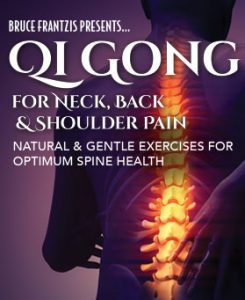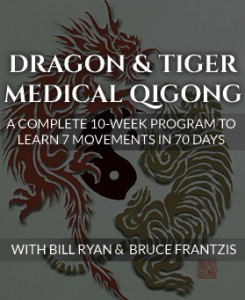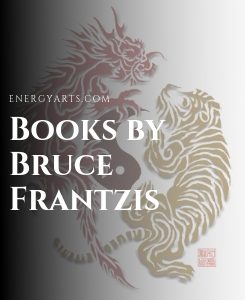There are five major branches of qigong in China. This article gives an overview of each of these branches, though if you wish to focus on a certain area, you may use these links to guide you to each individual topic within the blog:
Taoist Qigong
Taoist Qigong was China’s first qigong method, from which all other branches of qigong derived their techniques. In ancient China, Taoist meditation adepts from the Water tradition passed down through Lao Tse developed their inner awareness of chi flows. They directly perceived how to work with energy to maintain superior health, heal illness and realize profound inner stillness and spirituality. These adepts began to create and systematize qigong, the foundation for traditional Chinese medicine, acupuncture, self-healing energy work, tai chi and therapeutic qigong bodywork (qigong tui na).
Taoist qigong from the original Water tradition is based on softness and is valued for its ability to regenerate the body. As you move into middle age and beyond, the techniques can enable you to feel and function as if you were still in your twenties or thirties.
Taoist qigong works with your physical motions and energetic systems and the way in which they precisely affect specific parts of the body. This includes the muscles, connective tissues (ligaments, fascia, tendons), bones, joints, fluids, nerves, internal organs and glands, as well as all the energy channels, points and centers (tantiens) and mind states. The ability to become aware of and control the flow of chi is codified in the sixteen neigong components. These components are the foundation for some or all of the techniques of every major qigong system in China. Each physical and energetic component of neigong includes many different techniques and permutations.
Hundreds of Taoist qigong forms exist. These practices allow people to control the movement of their own life force, first through physical movements that increase chi. Advanced techniques use the mind alone to direct the flow of chi. The neigong components help open the mind and calm the heart by emphasizing inner stillness, emptiness, letting go, softness and relaxation.
Although its work can be subtly intense, the trademarks of Taoist qigong in its purest form are:
- Complete relaxation of the body’s muscles, tendons and ligaments
- Smooth, even, silent breathing without ever holding the breath
- Movements that are soft, smooth, fluid, and circular with a sense of ease and comfort
- Total use of all your effort but only to the point of not creating internal strain
- Physical stretches that are accomplished by release, relaxation and letting go of tension in the nerves and mind, instead of relying on force or willpower to push the muscles.
Tai chi and other internal martial arts practices, some of which were not fully developed until the nineteenth century, fall within the definition of Taoist qigong because they are based on neigong. In general, you can expect to attain similar health and relaxation benefits from practicing any Taoist internal martial art. However, most Taoist qigong can be done without needing to engage in self-defense practices.
Buddhist Qigong
Buddhist qigong originated from India’s Hatha yoga and pranayama (breath and energy control) tradition. It traveled into China through two main sources. First, it came to the Shaolin Temple (home of kung fu) in central China, where it was taught to Buddhist monks to make their bodies strong enough to withstand prolonged meditation sessions and stay healthy. The second source of Buddhist qigong is the Tantric tradition of Tibet, from where it spread throughout western China and moved eastward.
Buddhist qigong’s trademarks tend to be hard, sometimes jerky and often linear movements.
There may be forceful physical and energetic expression as well as strain, overt physical exertion and muscular tension. Stretching may often be accomplished through force of will instead of internal release. Buddhist qigong practitioners may hold their breath, shout and use explosive exhales. First they may release tremendous amounts of energy, sometimes in a very cathartic manner, to open their minds and expel embedded aggression and negative emotions. These releases then may be followed by deep relaxation and internal experiences of stillness.
Over time, Taoist and Buddhist qigong practices influenced each other and led to many offshoots. For example, in the Shaolin Temple, where people from the Chan (Zen Buddhist) and Taoist kung fu traditions met, Zen adopted many Taoist influences. Similarly, in the twelfth century, many of the qigong methods of Tibetan Buddhism, especially those that used copious visualizations and sound vibration techniques, found their way into the Taoist chi practices of the neo-Taoist (Fire) tradition. The Fire method was developed about 1,500 years after the original Taoist Water tradition.
The next three types of qigong borrow specific techniques from both Taoist and Buddhist qigong and focus on specific functions and benefits.
Confucian or Intellectual Qigong
Confucian qigong focuses on enhancing all aspects of mental and intellectual capacities and mitigating the stress and strain that intellectual effort engenders. Many of its basic chi techniques originally derived from Taoist qigong. However, because Confucians were China’s largest group of intellectual workers for 2,500 years, intellectual qigong is commonly called “Confucian qigong.” These workers formed the great political, academic, business, administrative and strategic planning backbone of the ancient world’s most populous nation.
Confucians worked extensively with all manner of complex mental activity and creativity. This work included artistic talents such as calligraphy, painting and writing ten-thousand character ideograms.
The techniques of Confucian qigong focus on enhancing intellectual intelligence, creativity, perception and attention span as well as developing unusual and special intellectual capacities. There are techniques for energizing the brain while keeping it calm and relaxed without making it overactive.
Medical Qigong
Medical qigong is a special application of qigong that is used to help people with chronic diseases and injuries. Medical qigong programs are typically based on the principles of Chinese acupuncture and the body’s meridian system.
Typically medical qigong is used in conjunction with other forms of Chinese medicine, such as acupuncture, herbs and ordinary massage. In the West, it is often used as complementary therapy to Western medical practices.
Medical qigong is used in the following ways:
- To heal and regenerate the body in various ways
- To target specific illnesses with specific qigong sets
- To create prescriptions that changes over time depending on the progress of the individual
- As a form of treatment by therapists who practice qigong tui na to move and re-balance energy in a client’s body
Martial Art Qigong
The primary goal of martial art qigong is to make the body so vibrant and energized that normally unavailable levels of power, speed, coordination, sensitivity and reflexes, as well as unusual physical and mental abilities, can be accessed and cultivated. It can turn ordinary human beings into people with extraordinary, high-performance capacities.
The underlying philosophy of the better schools of martial arts is to first make the body healthy with balanced chi, and then make the body and mind exceptionally strong and stable. Martial art qigong is ideal for athletes who wish to maximize their physical talents and control to reach the cutting edge of competitive ability.






0 Comments